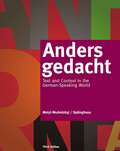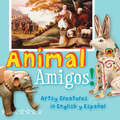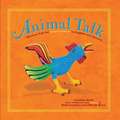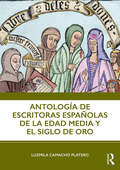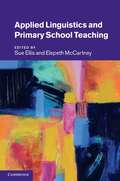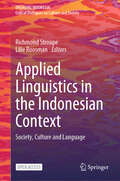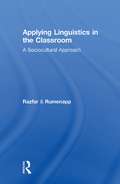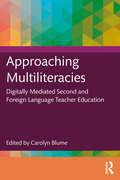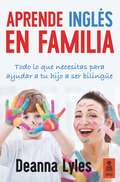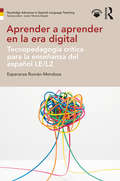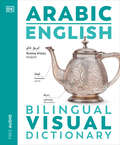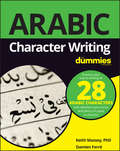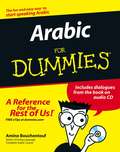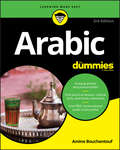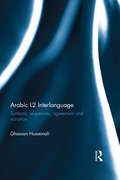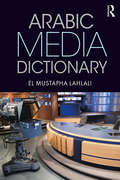- Table View
- List View
And Justice for ELs: A Leader′s Guide to Creating and Sustaining Equitable Schools
by Ayanna C. CooperAnd Justice for ELs is a resource every school leader must read right away—for that matter, keep within arm’s reach because you’re certain to refer to it constantly. Ayanna Cooper, a former U.S. Department of State English Language Specialist, has "been there, done that" and is now prepared to share with you how best to translate today’s federal mandates into actionable steps for ensuring the civil rights of our nation’s multilingual learners. Because it is impossible to provide specific advice or guidance for every possible situation, Ayanna focuses on the "need-to knows" for making informed decisions within your own building: Eight questions you must ask—and how to obtain answers—before planning English language development services The most common EL program models, with special emphasis on scheduling, along with specific challenges and appropriate staffing The why and how of evaluating English language education, regardless of the evaluation tool, and ways to facilitate conversations with teachers before and after observation How to determine the type of professional learning that will have the greatest impact in your unique context Recommendations for establishing productive relationships with linguistically diverse families and communities Just about every tool you could possibly need, including a glossary of acronyms, useful advocacy organizations, and templates for supporting professional learning But what you’ll love most is the way Ayanna "keeps it real." Every chapter is framed around a "What Would You Do?" scenario, for which she ultimately provides an answer(s) as well as guiding questions to help you think through the issues. Take a look for yourself. We know you’ll agree that And Justice for ELs is without question a one-of-a-kind resource. "And Justice for ELs is an excellent guide for practitioners who seek to provide their English learners with high-quality instruction in all subject areas. Too often such students are relegated an education that marginalizes them academically and fails to develop their native language skills. We can and must do a better job for these students, and in this book Ayanna Cooper shows us how." ~Pedro A. Noguera
And Justice for ELs: A Leader′s Guide to Creating and Sustaining Equitable Schools
by Ayanna C. CooperAnd Justice for ELs is a resource every school leader must read right away—for that matter, keep within arm’s reach because you’re certain to refer to it constantly. Ayanna Cooper, a former U.S. Department of State English Language Specialist, has "been there, done that" and is now prepared to share with you how best to translate today’s federal mandates into actionable steps for ensuring the civil rights of our nation’s multilingual learners. Because it is impossible to provide specific advice or guidance for every possible situation, Ayanna focuses on the "need-to knows" for making informed decisions within your own building: Eight questions you must ask—and how to obtain answers—before planning English language development services The most common EL program models, with special emphasis on scheduling, along with specific challenges and appropriate staffing The why and how of evaluating English language education, regardless of the evaluation tool, and ways to facilitate conversations with teachers before and after observation How to determine the type of professional learning that will have the greatest impact in your unique context Recommendations for establishing productive relationships with linguistically diverse families and communities Just about every tool you could possibly need, including a glossary of acronyms, useful advocacy organizations, and templates for supporting professional learning But what you’ll love most is the way Ayanna "keeps it real." Every chapter is framed around a "What Would You Do?" scenario, for which she ultimately provides an answer(s) as well as guiding questions to help you think through the issues. Take a look for yourself. We know you’ll agree that And Justice for ELs is without question a one-of-a-kind resource. "And Justice for ELs is an excellent guide for practitioners who seek to provide their English learners with high-quality instruction in all subject areas. Too often such students are relegated an education that marginalizes them academically and fails to develop their native language skills. We can and must do a better job for these students, and in this book Ayanna Cooper shows us how." ~Pedro A. Noguera
Anders Gedacht: Text And Context In The German-speaking World (World Languages Ser.)
by Irene Motyl-Mudretzkyj Michaela SpäinghausDieses vollständig auf Deutsch verfasste inhaltsbasierte Programm bereitet Deutschschüler auf mittlerem Niveau darauf vor, in zwischenmenschlichen, interpretativen und präsentativen Formen sinnvoll zu kommunizieren. Mit einem anregenden, vergleichenden Fokus auf Themen wie zeitgenössische Politik, Umwelt, Geschichte, Film, Musik, bildende Kunst, Literatur und Technologie fördert ANDERS GEDACHT, Dritte Ausgabe den kreativen Selbstausdruck sowie das kritische Denken über die deutsche Sprache und Gegenwartskulturen im deutschsprachigen Raum. Der Text bindet die Schüler durch induktive Grammatikanweisung und -wiederholung in den Lernprozess ein; kulturelle Interpretation; Analyse und Vergleich mit der eigenen Kultur; und interaktives, aufgabenbasiertes Üben.
Anglophone Students Abroad: Identity, Social Relationships, and Language Learning
by Rosamond Mitchell Kevin McManus Nicole Tracy-VenturaAnglophone students abroad: Identity, social relationships and language learning presents the findings of a major study of British students of French and Spanish undertaking residence abroad. The new dataset presented here provides both quantitative and qualitative information on language learning, social networking and integration and identity development during residence abroad. The book tracks in detail the language development of participants and relates this systematically to individual participants’ social and linguistic experiences and evolving relationship. It shows that language learning is increasingly dependent on students’ own agency and skill and the negotiation of identity in multilingual and lingua franca environments.
Animal Amigos!
by San Antonio Museum of ArtWhat better way to learn animal names than with eye-catching works of art. With work from across Latin America and beyond, children will become armchair world travelers and art connoisseurs. This bilingual edition introduces early readers, and earlier listeners, to animals in both English and Spanish.
Animal Talk: Mexican Folk Art Animal Sounds in English and Spanish (First Concepts in Mexican Folk Art)
by Cynthia WeillDid you know that animals that live in one country don't always talk the same language as animals from somewhere else? Take a rooster, for instance. In English-speaking countries, he says cock-a-doodle-doo when he has a notion to announce himself or to greet the dawn. But in Spanish-speaking countries, he says ki-kiri-ki. Emerging readers will delight in identifying the animals depicted on each new page. And the bilingual text invites parent and child into an interactive and playful reading experience for acting out animal sounds in English and Spanish. <p>Craftsman Rubí Fuentes and Efraín Broa from the Mexican state of Oaxaca fill the pages of Animal Talk with vibrant, wildly imaginative figures of familiar animals. Animal Talk is the fifth book in Cynthia Weill's charming First Concepts in Mexican Folk Art series. It is her passion to promote the work of artisans from around the world through early concept books.
Antología de escritoras españolas de la Edad Media y el Siglo de Oro
by Luzmila Camacho Platero; Javier Muñoz-BasolsAntología de escritoras españolas de la Edad Media y el Siglo de Oro ofrece una selección de obras literarias de ocho escritoras medievales, renacentistas y barrocas. Cada capítulo presenta una extensa introducción sobre la autora y su obra. Esta antología contribuye a mejorar el conocimiento de los estudiantes sobre la lengua, la literatura y la cultura españolas, al igual que ofrece una lectura desde la perspectiva de género de estas escritoras. Acompañada de textos originales modernizados al castellano actual, notas aclaratorias, actividades y una extensa y actualizada bibliografía, Antología de escritoras españolas de la Edad Media y el Siglo de Oro muestra la evolución de voces femeninas a lo largo de estos siglos. Las actividades sugeridas para cada capítulo ayudan a exponer y a reflexionar sobre la relevancia cultural que en la actualidad tienen los argumentos que estas mujeres proponent en sus trabajos. Esta antología será de gran utilidad para estudiantes de literatura y cultura españolas de niveles de grado y graduado e, igualmente, para los estudiantes hispanohablantes de literature comparada y de estudios de género.
Análisis de la Conversación: fundamentos, metodología y alcances
by Chase Wesley Raymond Luis Manuel OlguínAnálisis de la Conversación: fundamentos, metodología y alcances ofrece la primera introducción comprehensiva al Análisis de la Conversación (AC) en español y con datos conversacionales disponibles en línea. El libro está organizado en nueve capítulos. En los capítulos iniciales, se presenta el AC como una disciplina y método analítico para el estudio del habla y otras formas de conducta humana en la interacción social, se hace un breve recuento histórico del desarrollo de la perspectiva analítico-conversacional y se introduce a los lectores al sistema de transcripción usado en el AC. Los capítulos siguientes están dedicados a explorar cuatro dominios claves en la organización de la conversación espontánea: la toma de turnos, las secuencias de acciones, la preferencia y la enmienda, destacando la importancia de prácticas del diseño de turno en cada dominio. Seguidamente, se discute la conexión entre organizaciones y prácticas del habla en interacción y contextos sociales e identidades de los participantes en conversación. El libro concluye ofreciendo una serie de sugerencias para la investigación analítico-conversacional en español y señalando su relevancia para la indagación de la interacción en contextos legales, políticos, médicos, tecnológicos, entre otros. Cada capítulo incluye ejemplos tomados de conversaciones auténticas en distintas variedades de español, cuyos audios pueden ser consultados directamente en línea. Con el fin de revisar y profundizar lo aprendido, cada capítulo ofrece un apartado final con preguntas, actividades y lecturas adicionales. Como apéndices al libro, se ofrecen, además, un glosario de términos bidireccional español–inglés y un sumario con las convenciones de transcripción más usadas. Escrito enteramente en español, el libro ofrece una introducción actual, comprehensiva y amigable al AC y sus aplicaciones por lo que constituye una fuente de referencia ideal para estudiantes, instructores e investigadores en lingüística (hispánica), sociología y comunicaciones. Análisis de la Conversación provides the first comprehensive, Spanish-language introduction to the field of Conversation Analysis (CA), utilizing conversational data that is publicly available online. The book is organized in nine chapters. The opening chapters introduce Conversation Analysis as a unique theory and method to study language and other forms of conduct in social interaction. Readers are presented with a history of the development of this framework for analyzing interaction and introduced to the transcription system used in CA. The following chapters explore four key domains of organization within spontaneous conversation—turn-taking, preference, sequence, and repair—highlighting the importance of turn design practices in each. The authors then review the connection of these organizations and practices to social contexts and participant identities, and they conclude by suggesting a range of avenues for future research on Spanish conversation, including its relevance in specific legal, political, medical, and technological settings. Each chapter includes a variety of examples from authentic Spanish conversation, which readers can consult directly online. Each chapter is additionally accompanied by a set of questions and activities that allow readers to check and reinforce their understanding, as well as lists of additional readings for readers interested in more specific topics. Glossaries of technical vocabulary—both Spanish-English and English-Spanish—are included as appendices, along with a summary of transcription system notation. Written entirely in Spanish, this book presents a thorough and engaging introduction to Conversation Analysis and its applications. It is ideal for students, instructors, and researchers in Hispanic Studies, (Spanish) Linguistics, Sociology, and Communication Studies.
Applied Linguistics and Primary School Teaching
by Sue Ellis Elspeth MccartneyModern primary teachers must adapt literacy programmes and ensure efficient learning for all. They must also support children with language and literacy difficulties, children learning English as an additional language and possibly teach a modern foreign language. To do this effectively, they need to understand the applied linguistics research that underpins so many different areas of the language and literacy curriculum. This book illustrates the impact of applied linguistics on curriculum frameworks and pedagogy. It captures the range of applied linguistics knowledge that teachers need, and illustrates how this is framed and is used by policy makers, researchers, teacher educators and the other professions who work with teachers in schools. It considers how to effect professional development that works. It is essential reading for primary teachers but also for speech and language therapists, educational psychologists, learning support teachers and all those doing language or literacy research in the primary classroom.
Applied Linguistics in the Indonesian Context: Society, Culture and Language (Engaging Indonesia)
by Richmond Stroupe Lilie RoosmanThis open access edited volume presents a series of studies utilizing a variety of linguistic research techniques to investigate areas of language education, acquisition and assessment, contemporary political debate, modern and historical print media, and clinical language disorders, in the Indonesian context. In doing so, the authors provide a rich and diverse overview of current research in the fields of linguistics and applied linguistics. The initial section focuses on research conducted in educational settings, focusing on English-medium instruction (EMI), reading assessment, discovery-based learning, cultural elements in textbooks, and pre-service teacher preparation in Indonesia, offering recommendations for improving language education. The second section demonstrates the applications of corpus linguistics, focusing on collocation patterns in different languages, lexical use and context of rhetorical markers, and authorship determination. A third section presents investigations related to aspects of historical and contemporary language use in a variety of contexts, including advertisements, political debate, Indonesian print media, and translanguaging and multilingual writings, discussing the social and cultural dimensions of language use in Indonesia. The final section focuses on clinical linguistics, investigating the relationship between language disorders and language use, including spoken narratives provided by patients with Alzheimer's and the structure and time reference use of agrammatic speakers, with valuable insights into the understanding, diagnosis and treatment of language disorders. Brought together in a single volume, the chapters illustrate how linguistic analysis can be applied across a variety of disciplines and research sites. The volume is relevant to linguists, educators, sociologists, historians, and members of the medical community with particular interest in the Indonesian context.
Applying Anzalduan Frameworks to Understand Transnational Youth Identities: Bridging Culture, Language, and Schooling at the US-Mexican Border (Routledge Research in Educational Equality and Diversity)
by G. Sue Kasun Irasema Mora-PabloFramed by the theoretical work of Gloria Anzaldúa, this volume focuses on the cultural and linguistic practices of Mexican-origin youth at the U.S. border to explore how young people engage in acts of "bridging" to develop rich, transnational identities. Using a wealth of empirical data gathered through interviews and observations, and featuring perspectives from multinational and transnational authors, this text highlights how youth resist racialized and raciolinguistic oppression in both formal and informal contexts by purposefully engaging with their heritage culture and language. In doing so, they defy deficit narratives and negotiate identities in the "in-between." As a whole, the volume engages issues of identity, language, and education, and offers a uniquely asset-based perspective on the complexities of transnational youth identity, demonstrating its value in educational and academic spaces in particular. This text will benefit researchers, academics, and educators with an interest in the sociology of education, multicultural education, and youth culture more broadly. Those interested in language and identity studies, as well as adolescence, schooling, and bilingualism, will also benefit from this volume.
Applying Linguistics in the Classroom: A Sociocultural Approach
by Aria Razfar Joseph C. RumenappMaking linguistics accessible and relevant to all teachers, this text looks at language issues in the classroom through an applied sociocultural perspective focused on how language functions in society and in schools—how it is used, for what purposes, and how teachers can understand their students’ language practices. While touching on the key structural aspects of language (phonetics, phonology, morphology, and syntax), it does not simply give an overview, but rather provides a way to study and talk about language. Each chapter includes practical steps and suggests tools for applying different kinds of linguistic knowledge in classrooms. The activities and exercises are adaptable to elementary or high school settings. Many examples focus on the intersection of math, science, and language. Teacher case studies show how real teachers have used these concepts to inform teaching practices. Given the increasing use of multimedia resources in today’s schools, multiple mediums are integrated to engage educators in learning about language. The Companion Website provides a multitude of relevant resources that illustrate the diversity of language functions and debates about language in society.
Approaching Multiliteracies: Digitally Mediated Second and Foreign Language Teacher Education
by Carolyn BlumeApproaching Multiliteracies: Digitally Mediated Second and Foreign Language Teacher Education provides practical insights into developing the multiliteracies pedagogy competencies for pre-service teachers. It highlights how multiliteracies pedagogy can be not just a goal of teacher education, but also a means to prepare future language teachers for this task.Capitalizing on parallels between multiliteracies pedagogy and current models of second and foreign language teacher education (SFLTE), the chapters in the book illustrate how teacher educators in Europe, Asia, and the United States connect new forms of digitally mediated communication with principles of initial professionalization. Integrating examples from their own practice with empirical analysis, a team of international contributors provide models of instruction that can be adapted for a variety of settings. This edited collection examines a range of methodological approaches, from engaging in identity work to the use of corpora, that cultivate future language teachers’ dispositions and skills in integrating multiliteracies into foreign language classrooms in ways that are contextually situated, critical, and digitally mediated.Primarily designed for individuals involved in language teacher education, the book will also be a key resource for in-service professional development opportunities focusing on contemporary language learning and use, as well as for researchers interested in efficacious models of SFLTE.
Aprenda Inglés Con La Ayuda De Dios: Un manual básico para el buen uso del inglés
by Francisco GuellEl inglés es un idioma difícil de aprender para muchos. Por eso, este libro está diseñado como un manual sencillo y fácil de usar. Toda persona que esté decidida a aprender inglés para desempeñarse mejor en sus estudios, su profesión, los negocios o, simplemente, en su diario vivir, ahora lo podrá lograr ¡con la ayuda de Dios! El autor, Francisco B. Güell, le enseña principios básicos de gramática inglesa y, basándose en su propia experiencia, expone ejemplos sencillos y prácticos para la vida cotidiana. A diferencia de otros libros, éste le provee herramientas claves como:- Pronunciar correctamente el inglés leyéndolo en español- Entender los verbos fundamentales y su uso correcto- Saber las vocales y las consonantes inglesas- Aumentar el vocabulario con ejercicios prácticos- Aprender frases usadas en supermercados, visitas médicas o restaurantes- Conocer sobre la ciudadanía estadounidense y sus trámites- ¡ Y mucho más con la ayuda de Dios!
Aprende inglés en familia: Todo lo que necesitas para ayudar a tu hijo a ser bilingüe
by Deanna Lyles¿Has pensado cuánto te gustaría poder hablar inglés con soltura? ¿Y ayudar a que tus hijos lo aprendan de pequeños como tú no pudiste hacerlo? Aprende inglés en familia tiene todo lo que necesitas para conseguir ambos objetivos de forma fácil y divertida. Que dos padres no nativos críen un hijo bilingüe es mucho más fácil de lo que parece, y este libro te proporcionará todo lo que necesitas para llevarlo a cabo. Tras un repaso básico sobre el bilingüismo y cómo se aplica a los niños, aquí encontrarás cientos de palabras y expresiones de la vida diaria, además de un sinfín de trucos y consejos que te enseñarán cómo lograr que tus hijos sean bilingües gracias a las canciones, los juegos, los cuentos, el vocabulario y las expresiones que forman parte de la cultura infantil anglosajona desde hace generaciones. También descubrirás cómo desarrollar un plan de bilingüismo específicamente diseñado para tu familia, para que podáis dar pasos firmes hacia vuestro objetivo. ¿Por qué no empezar a mejorar el inglés de toda la familia hoy mismo?
Aprender a aprender en la era digital: Tecnopedagogía crítica para la enseñanza del español LE/L2
by Esperanza Román-MendozaAprender a aprender en la era digital provides a comprehensive, state-of-the-art account that empowers readers to leverage learning technologies to promote second language learner autonomy. Written entirely in Spanish, the book covers a breadth of innovative topics in the teaching of Spanish via and with technology, such as emerging pedagogies, autonomous and participatory learning, learner agency and identity, teacher development, and post-communicative curriculum design. Key features: a novel and unique approach, combining the latest research on learning autonomy and instructional technologies in language learning; an emphasis on the connections between theory and practice, with concrete suggestions for using technology in the classroom; an extensive selection of curricular and pedagogical tools that can be easily adapted to various teaching and learning environments and needs; a broad selection of bibliographical references for further reading and research; a bilingual glossary of key techno-pedagogical terms; a catalogue with over 250 tools for second language learning and teaching, with contextualized examples of their practical application; a comprehensive eResource with a wealth of additional materials, including access to a database of technological tools and best practices in teaching Spanish with technology. Written in a clear and accessible manner, Aprender a aprender en la era digital is ideal for instructors of Spanish at all educational levels. The book will also be of great interest to teachers of languages other than Spanish, as well as graduate students pursuing a degree in Spanish, Educational Technology or Language Education.
Arabic
by Karin C. RydingThis new edition, updated and with additional exercises, equips those who work, travel, and study in Arab countries with an educated form of spoken Arabic that functions flexibly in the face of various regional colloquial variants in the Arab world. Because the Arabic language has a number of very different spoken vernaculars, being able to speak and be understood in all Arab countries has become a challenge for English speakers. Ryding and Mehall have designed a course that teaches a standardized variant of spoken Arabic that is close to, but more natural than, the literary Modern Standard Arabic. With a non-grammar-based approach, this book fosters communicative competence in Arabic on all levels and develops speaking proficiency without abandoning Arabic script. It has proven to be clear, effective, and relevant to the needs of Americans living and working in the Arab East. Task-based lessons feature basic dialogues between Americans and Arabs, explanations of new structures, vocabulary expansion, and exercises; and provide gradual access to the sounds and script of Arabic by emphasizing listening and reading comprehension first, then slowly adding oral exercises and activities until the student has achieved basic proficiency. Not intended for self-instruction for beginners, Formal Spoken Arabic Basic Course with MP3 Files assumes some previous knowledge of Modern Standard Arabic, Arabic script and phonology, and previous or simultaneous instruction in orthography. This new edition includes a CD of MP3 audio exercises that are keyed to the text and drill students on listening and speaking. Lessons cover topics including:Heads of StateCities and CountriesOfficial TitlesGeographySystems of GovernmentLost LuggageGetting AcquaintedEstablishing Common GroundSeeking and Giving InformationPersonal Needs and FamilyHandling ProblemsEating OutBargaining and Buying
Arabic - English Bilingual Visual Dictionary (DK Bilingual Visual Dictionaries)
by DKWith more than 6,750 fully illustrated words and phrases in Arabic and English, along with a free bilingual audio app, DK's Arabic-English Bilingual Visual Dictionary is your essential companion to learning Arabic.You will find all the words and phrases you need to buy food and clothes, talk about work and education, visit the doctor, go to the bank, use public transportation, and much more. Perfect for students, tourists, and business travelers, the dictionary is incredibly easy to follow, with thematically organized vocabulary so you can find closely related words on a particular topic. Words and phrases are illustrated with full-color photographs and artwork, helping to fix new vocabulary in your mind. The supporting audio app enables you to hear all the words and phrases spoken out loud in both languages to help you learn, remember, and pronounce important vocabulary.
Arabic Character Writing For Dummies
by Keith Massey Damien FerréLearn to write in Arabic In Arabic, there are different levels of language. The written language, which is studied in this book, is literary Arabic, sometimes also called classical Arabic or even modern or standard Arabic. It is the language of the Quran, classical poetry, literature and the media. The Arabic plume consists of 28 consonants and three long vowels. Each consonant is accompanied by a vowel which is placed above or below the consonant. Arabic speakers are in great demand in the United States, due to the country's political commitments to the Middle East, but only 25 percent of non-native speakers know the language in enough detail to function as translators, interpreters, analysts, or field agents. Arabic Character Writing For Dummies helps you write this language clearly and correctly. Learn to write the Arabic alphabet Find free instructional videos, flashcards, and printable writing pages online Build upon your mastery of the language Get ahead at work or in your personal life Arabic Character Writing For Dummies is designed for beginners, students, and lifelong learners wishing to write in Arabic.
Arabic For Dummies
by Amine BouchentoufRegarded as one of the most difficult languages to learn for native English speakers by the U. S. State Department, Arabic is gaining both prominence and importance in America. Recent world events have brought more and more Americans and other English speakers into contact with Arabic-speaking populations, and governments and businesses are increasingly aware of the importance of basic Arabic language skills. Arabic for Dummies provides you with a painless and fun way to start communicating in Arabic. Why should you learn Arabic? Well, besides the fact that over 200 million people in more than 22 nations use it to communicate, there are tons of reasons to get up to speed this 1,400 year old language, including: Nearly all of the Middle-East speaks Arabic or one of its dialects Basic Arabic skills are extremely useful for anyone traveling to, doing business in, or serving in the Middle East It is the language in which the Koran is written There is a rich, centuries-old literary tradition in Arabic Arabic For Dummies presents the language in the classic, laid-back For Dummies style. Taking a relaxed approach to this difficult language, it's packed with practice dialogues and communication tips that will have you talking the talk in no time. You'll get the scoop on: The Arabic alphabet, pronunciation, basic grammar, and the rules of transliteration The history of the language and information on classical Arabic and its dialects How to make small talk and make yourself understood when dining, shopping, or traveling around town How to communicate on the phone and in business conversations Handy words and phrases for dealing with money, directions, hotels, transportation, and emergencies Arabic culture and etiquette, including ten things you should never do in Arabic countries The book also includes an Arabic-English dictionary, verb tables, and an audio CD with dialogues from the book to help you perfect your pronunciation. Written by a native Arabic speaker who helped start a year-round Arabic department at Middlebury College, Arabic For Dummies is just what you need to start making yourself understood in Arabic. Note: CD-ROM/DVD and other supplementary materials are not included as part of eBook file.
Arabic For Dummies
by Amine BouchentoufStart reading and speaking Arabic Arabic For Dummies helps readers start speaking Modern Standard Arabic in no time. Whether you’re a student, traveler, or work in business or government, you’ll find this title to be packed with practical lessons, cultural facts, and handy references. Inside, you’ll find guidance on basic grammar, as well as the necessary vocabulary to make introductions and greetings, use proper etiquette, make small talk, make transportation arrangements, order food and beverages, ask directions, deal with money, shop, access recreation, and handle an emergency. Features new and revised content Offers a revamped, user-friendly design to both pedagogy and organization Includes expanded coverage of grammar, verb conjugations, and pronunciations Get free access to conversational audio tracks online If you want to start speaking Arabic, this go-to book is packed with practical instruction, cultural facts, and handy references you won’t want to be without!
Arabic Genre Pedagogy: Teaching, Learning, and Assessing in Context (Topics in Arabic Applied Linguistics)
by Myriam Abdel-MalekArabic Genre Pedagogy: Teaching, Learning, and Assessing in Context views Modern Standard Arabic and all spoken varieties of Arabic as one system and offers genre-based instructional resources grounded in systemic functional linguistics (SFL) and genre theory. Divided into three parts, this book explores the Theoretical and Instructional Framework, Spoken Genres, and Written Genres with chapters focusing on everyday social genres including exchanging information, chit-chat, and complaints. This book is aligned with the ACTFL framework and the instructional goals for each genre are articulated in terms of the ACTFL Can-Do Statements. Designed to support instructors of Arabic novice-intermediate learners, the chapters offer step-by-step lessons with practical classroom activities on how to make the language related to each genre explicit to students. Arabic Genre Pedagogy serves as a valuable guide and professional development resource for instructors of Arabic as a world language and for researchers of SFL-informed genre-based approach.
Arabic Grammar in Context (Languages in Context)
by Mohammad AlhawaryArabic Grammar in Context offers a unique and exciting approach to learning grammar. It presents grammar as a necessary and essential tool for understanding Arabic and for developing comprehension and production skills. Features include: authentic texts from a rich variety of sources, literary and non-literary, used as the starting point for the illustration and explanation of key areas of Arabic grammar clear and authoritative demonstration of the relevance of grammar for understanding and interpreting Arabic a wide range of appropriate exercises designed to consolidate learning fully vocalized exercises and texts a glossary of vocabulary and expressions provided at the end of the book audio readings of the texts available online for additional listening practice. Suitable for class use and independent study, Arabic Grammar in Context is ideal for intermediate to advanced learners of Arabic.
Arabic L2 Interlanguage: Syntactic sequences, agreement and variation (Topics in Arabic Applied Linguistics)
by Ghassan HusseinaliArabic L2 Interlanguage is a significant and timely addition to the field of Second Language Acquisition, providing valuable insight into the development of ‘interlanguage’, the interim language of early beginners, in learners of Arabic. This book: Clearly establishes what interlanguage is and why it should form an important part of foreign language teaching Presents the reader with a sequence in which six English-speaking learners of Arabic acquire the language Makes use of the rich morphological and syntactic property of Arabic to offer a new perspective on the field of Second Language Acquisition. Arabic L2 Interlanguage contributes directly towards building a more comprehensive theoretical framework for explaining how L2s are acquired. It will be key text for SLA scholars as well as an important resource for graduate students in Linguistics and Foreign Language Teaching.
Arabic Media Dictionary
by El Mustapha LahlaliArabic Media Dictionary is designed to equip students with translations of terms from Arabic into English. Covering Arabic language mass media, this up-to-date dictionary enables easy reference of media terminologies and phrases, and the acquisition of a wide range of terms related to different media themes and registers.This dictionary offers a wide range of Arabic media entries, which have been translated and contextualised in authentic Arabic media texts, some of which have been extracted from Arabic newspapers and online Arabic media sources.Containing more than 6500 entries with sample sentences, this dictionary is a vital reference for students of Arabic translation, journalists, Arabic instructors and learners of Arabic at intermediate and advanced levels. The dictionary is structured in alphabetical order, accompanied with an Arabic index for easy access.

